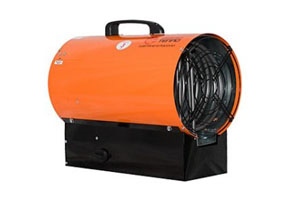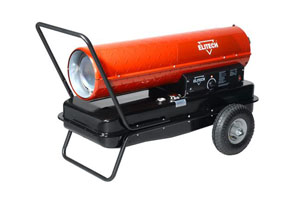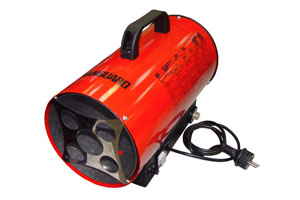 Now you will not surprise anyone by mentioning such a name as a heat gun. If we talk about this tool constructively, then this tool is a very powerful heating device with a built-in fan, due to which a powerful stream of hot air is created. The scope of heat guns is quite extensive. If you need to quickly heat the air in a large unheated room, then it is impossible to do it differently, without using this tool.
Now you will not surprise anyone by mentioning such a name as a heat gun. If we talk about this tool constructively, then this tool is a very powerful heating device with a built-in fan, due to which a powerful stream of hot air is created. The scope of heat guns is quite extensive. If you need to quickly heat the air in a large unheated room, then it is impossible to do it differently, without using this tool.
Heat guns are used to heat garages in the winter, if there is a long time for nuts, but there is no heating in the garage. Very often, heat guns are used in construction for heating draft rooms before finishing. And of course in agriculture as a temporary measure so that the crop does not freeze.
Types of heat guns
Heat guns differ in many characteristics. In this article, we use the classification of heat guns according to the type of heating element. In general, they are divided into 3 classes on this basis: electric, liquid fuel and gas. Heat guns of small size and power usually have a special stand so that you can direct the flow of hot air at an angle to the floor on which it is installed. For large cannons, a special cart on wheels is usually used. Thus, they are easier to transport.
Also common to all types of this tool is the presence of a thermostat. As a rule, it is connected to the power supply system of the tool and allows you to automatically turn off the device to save fuel or simply when the ambient temperature reaches the required threshold. Thermostats used in heat guns allow adjustment in the range from 0 to 36 °C. The thermostat regulation accuracy is usually 1.5°C.
Gas and liquid-fuel heat guns have such an advantage over shady ones as reliability and durability. Due to their design, they are less sensitive to external shocks and shocks, they are very easy to transport, and are not afraid of high humidity. Due to this, they can easily be used in greenhouses and greenhouses. Their body is additionally covered with a durable anti-corrosion coating.
1. Electric heat guns.
Most people, when they hear about heat guns, mean exactly this type. Structurally, these heat guns are a powerful fan heater, the air in which is heated by a powerful heating element. As a rule, the size of the heat gun and its power directly depend on the power of the installed heating element. As advantages of this category of guns, it is worth noting the absence of fuel combustion products. Of course, the heating element will burn out oxygen, but not as intensively as it happens with other types of guns.
The downside of these guns is that electricity is needed to connect. If you are building a new house, for example, on a separate site where there are still power lines, you will have certain difficulties and you may have to start a gas generator. Yes, and it may not be enough if the gun is very powerful, for example, 10 kilowatts. During operation, electric heat guns are quite expensive, since electricity consumption is high, and it costs more and more. 
2. Kerosene heat guns.
If we talk about heat guns on liquid fuel, then they work either on kerosene or diesel fuel. The fuel is burned by a special burner and heats the air blown out by the fan. As a positive quality of this type of gun, it is worth noting its high efficiency. As an example, we can cite the following fact: a 15 kW cannon consumes only one liter of fuel per hour. Typically, the tank of liquid fuel heat guns is designed for refueling, providing about 12 hours of continuous operation.
Since these guns are equipped with thermostats and have an automatic ignition system, taking into account shutdowns at a sufficient air temperature, fuel can be enough for a couple of days of operation. It is worth saying that these guns are also equipped with a shutdown system in case of fire extinction, including when oxygen burns out.
Despite the fact that combustion results are highlighted as a result of work, you should not worry too much, since the design ensures almost complete combustion of fuel. However, in accordance with the operating instructions, the heated room must be periodically ventilated. If you are not stingy, you can purchase a model with exhaust gas removal, then you won’t have to worry about it anymore.
The most widely used liquid fuel heat guns are in agriculture. They are used to heat greenhouses and greenhouses during severe frosts as an additional source of heat, or as the only source of heat. If we make an economic calculation, it often turns out to be more profitable to heat greenhouses with heat guns than to create a permanent heating system from centralized sources of thermal energy.
Also, these guns are used when drying the harvested crop, before packaging or backfilling for storage.
3. Gas heat guns.
This category of heat guns also deserves great attention. The power of these guns is carried out from gas cylinders. As a rule, these heat guns have a small size and power. Thanks to this, gas heat guns have excellent mobility. Depending on the capacity of the cylinder, the operating time of the gun may vary. Those who need the gun to work longer use special adapters with which you can connect several cylinders at once. Propane is used as fuel.
The power of gas guns ranges from 10 to 80 kW, while fuel consumption is from 0.78 to 6.48 kg of gas per hour. Propane burns completely as in a gas stove, due to this, these heat guns can be used not only for heating industrial, but also for some parts of the premises.
Separately, it is worth noting such a scope of gas heat guns as the installation of stretch ceilings.
The fact is that during the installation process, heating of the film web is required. This is done with the help of a gas heat gun. Thus, we have tried in our article to bring all the features of a particular type of heat guns. Depending on the work you are planning, choose the one that suits you best. We did not dwell on the technical characteristics of the models, since you can find this information in the relevant sections of the site dedicated to the description of the tools.
|
Useful articles |
|
How to choose a stationery knife |